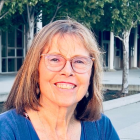Support strong Canadian climate journalism for 2025
These in-their-own-words pieces are told to Patricia Lane and co-edited with input from the interviewee for the purpose of brevity.
Joshua Ralph honours the lives of invasive plants. This 25-year-old, Vancouver-based artist hosts workshops teaching participants to make art supplies from plants removed in the work of restoring and rewilding.
Tell us about your project.
I spend a lot of my free time helping regenerate native ecosystems. This is important work as invasive plants pose numerous threats to native plant and animal populations. They often establish quickly in a damaged environment and reduce overall biodiversity by forming monocultures. While I understood all this when I participated in restoration, I was saddened by the piles of invasive plants tossed aside. It is not their fault they sprouted where they did. These plants were brought here by colonization and are doing what they do best: Growing.
Indigenous ways of knowing have helped me understand we must respect all of the more-than-human world if we are to thrive as a species. When I heard of people in Australia making art supplies from plants, I was inspired to try it here.
In the past three years, I have hosted free workshops helping more than 250 people in southwestern British Columbia make art from invasive species. We make art pencils from dried Himalayan blackberry canes, which are spongy and hard, and fill them with charcoal made from burning black locust trees. The ink is made in a similar way, with water and gum arabic added to charcoal from European mountain ash. We make paper from mixing and soaking recycled paper with otherwise wasted invasive plants, such as buttercups, English ivy and non-native grasses. The mixture can be quickly dried with antique flat irons and makes beautiful art paper.
People leave with a sense of satisfaction from making something useful which will enable them to create art. They love knowing they reduced their consumer goods consumption and participated, at least to some extent, in a circular economy. As we work, we talk about the plants we are repurposing and their histories and deepen our understanding of the importance of internalizing that we are part of nature and in nature. There is no waste. Participants tell me it is a very empowering, thought-provoking experience.
Since we work in a group, we build community. The combination of having done something meaningful together with others with similar values, which they can fairly easily copy at home, means people leave feeling hope and love. That brings me joy.
I am bringing the same values to a project sponsored by the Neighbourhood Small Grants Program for the South Vancouver Neighbourhood Food Hub. We provide envelopes filled with birdseed to 175 food bank clients. The envelopes carry information in six languages about local birds and ethical feeding practices. It feels good to provide better access to urban nature to people facing food insecurity.

How did the way you were raised influence your current path?
My parents have always supported me to do what makes me happy. They showed me that life satisfaction can mean more than working too hard to get that extra high mark. They aren’t environmental activists, but they are there for me in this work. They make great sounding boards and help me set realistic goals.
What makes your work challenging?
It is sometimes difficult to avoid wondering if I am making enough of a difference. But then I remember that small things add up and community makes them matter more.
What keeps you awake at night?
Ideas! I am constantly looking for ways to help folks understand that we cannot get where we need to go if we deride any part of the natural world, including ourselves.
What gives you hope?
There is no other real alternative. After all, we cannot concede defeat over what we have not yet lost. I am learning resilience from these invasive plants.
What advice might you have for other young people?
Use your imagination to understand the world you want to live in. It is not the one we have now. You and I are creating change, so let's become conscious of the kind of change we seek.
As we work for a better future, we can lift each other up by remembering every voice matters, and we get much more done if we do it together.
What about older readers?
We need your stories. Tell us how many fireflies there were that summer in your youth. Remind us that frog choruses were so loud that they used to keep you awake at night. Don’t let us forget what it was like to swim in clean lakes and breathe smoke-free air.







Comments
An excellent story. I'm impressed with Patricia's style of journalism that supports young people by telling their story through their own voice. This article is inspiring and is the good news we rarely hear and need to hear. Thank you Patricia!